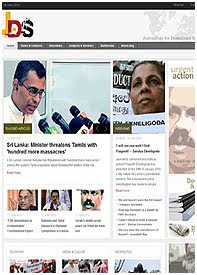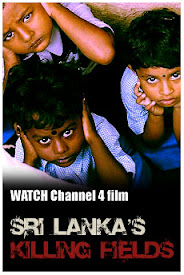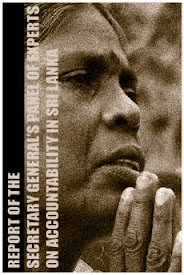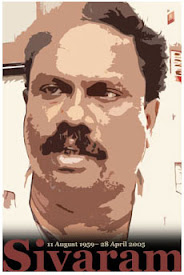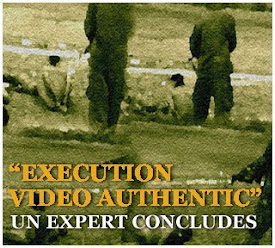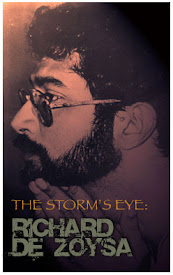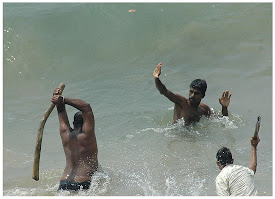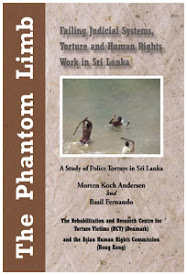
Agence France-Presse (AFP)
.............................................................................................................................................................................................
The government's Lessons Learnt and Reconciliation Commission (LLRC) is to hand over its findings to President Mahinda Rajapakse who set up the probe last year. Rights groups have already dismissed the LLRC as a white wash.
"The report of the LLRC to look into the cause of the conflict, its effects on the people and reconciliation will be made public after it is handed over to the President," the ministry said quoting Foreign Minister G. L. Peiris.
Peiris said the LLRC report will be made public, but only after the president has studied it.
The LLRC, comprising former government officials, was established in May last year with a November 15 deadline to complete its work.
"The President has categorically said that the report will be made public, but no exact dates can be given yet," the minister was quoted as saying.
International rights groups have been highly critical of the LLRC, saying that it was "flawed at every level" and was no substitute for an independent war crimes probe as demanded by many, including the US and the European Union.
London-based Amnesty International in September cited eyewitness testimony and information from aid workers suggesting that at least 10,000 civilians were killed in the final military drive that crushed Tamil separatists in May 2009.
Amnesty had said that the LLRC was just the latest in a long line of failed domestic inquiries, while Sri Lanka insists that it should not be pre-judged before the LLRC findings are made public.
An April report by a panel commissioned by UN Secretary General Ban Ki-moon noted "credible allegations" of war crimes committed by both sides -- Colombo denied the allegations, maintaining that troops did not kill a single civilian.
Sri Lanka has managed to stave off censure at UN forums thanks to the support of close allies China and Russia.
© AFP
Saturday, November 05, 2011
Sri Lanka to release controversial war report
Saturday, November 05, 2011
The continued militarization of Sri Lanka

By Gibson Bateman | Journal of Foreign Relations
.............................................................................................................................................................................................
Most of the LTTE’s leadership was killed. For the foreseeable future, it is hard to envision another Tamil nationalist movement taking up arms against the state.
Yet, if living in Sri Lanka, one might think that the conflict is still going on.
In post-war Sri Lanka, the militarization of the entire country has continued unabated. This development is less significant in the predominantly Sinhalese south, where military personnel are often viewed as heroes for defeating the LTTE. But in the mostly Tamil north and east, they are viewed as oppressors. Indeed the military’s presence in the north and east (both former LTTE strongholds where much of the fighting took place) is disturbing. State security personnel wield enormous influence over all aspects of people’s lives.
Precise statistics about military employment in Sri Lanka are not publicly available, but some of the most disturbing effects of this ubiquitous military presence are often left out of statistical analyses anyway. Members of the armed forces are literally everywhere. People are living in fear, especially single Tamil women who lost their husbands during the war.
Several weeks ago, a friend and I travelled along Sri Lanka’s A-9 in northern Sri Lanka, the road that leads from Vavuniya up to Jaffna. The entire area is teeming with army members. We passed through a number of checkpoints. What’s even more disturbing is the military’s obvious intrusion into civilian affairs. On our way up to Jaffna, my friend and I decided to grab a quick cup of coffee at what can be vaguely described as a Sri Lankan roadside café. We were served by an army guy. Army personnel are also working in various shops where household items are sold. I have read that the military has even gotten involved in tourism. This is absurd. The war is over. Tamil people already have been stripped of their dignity and they are now forced to live under de facto military occupation.
The local elections held in July in the country’s north and east show how unhappy people living there are. The ruling United People’s Freedom Alliance (UPFA) dominated the rest of the country, but they got little support in the north and the east. The government maintains that reconstruction and development in the north and east is going along swimmingly. This obviously is not the case. People in these areas have rejected the government’s development model, which focuses almost entirely on the pursuit of rapid economic growth as the way to address the legitimate concerns of the Tamil people. These people want a political solution; they want a genuine devolution of power. They want to stop being treated like inferior citizens in a land that they have occupied for thousands of years. But the Rajapaksa regime has given no indication it is open to a political settlement for the Tamil people.
To be clear, making significant reductions in military employment requires planning.
The last thing the Rajapaksa regime wants is large numbers of unemployed youth who just finished fighting a long war. That is a recipe for increased crime and civil unrest. But this government has not even thought about how decreasing military employment would work.
And, unfortunately, militarization fits in quite well with the current global political economy. Western countries like the US and the UK probably do not really care about a militarized Sri Lanka. Just like Western countries probably do not care about exploring the allegations of war crimes and crimes against humanity during the final phase of the conflict. The ambivalence from the international community to call for an international inquiry is obvious. Rather, the threat of an international investigation is probably just being used as leverage to try and get some form of a political settlement for the Tamil people. Besides, it is well-known that the Pentagon is pushing strongly for the US to open up a full-fledged military relationship with Sri Lanka.
The unnecessary militarization of Sri Lanka is a message that human rights groups (both domestic and international) have not articulated enough. There are a few important things to keep in mind. First, the government controls most of the media.
Second, there is already limited space to conduct human rights work in Sri Lanka.
While human rights defenders are brave, many would view talking about militarization as an unnecessary risk. Again, people are scared and fear is a powerful thing. The last point has to do with broader geopolitical trends and people’s desire to sell arms.
In spite of the Europe Union’s criticism of Sri Lanka’s human rights record, many member states have continued to sell weapons to the government since President Mahinda Rajapaksa first came to power in 2005. But this matters less when compared to China, which has been the country’s biggest arms dealer for the past couple decades. Add these arms sales to China’s ability to provide unconditional loans with alacrity, and it is no wonder that Rajapaksa regime has been looking east recently. As mentioned, the US Department of Defense has not given up on Sri Lanka either. The US government did sell arms to the government during the civil war and, as mentioned, there are many in Washington, DC who would like to see more weapons deals in the future.
For all of these reasons, a serious downsizing of the Sri Lankan military or a substantial decrease in military spending will remain unlikely for the foreseeable future.
© JoFR
Saturday, November 05, 2011
Indian military team visits Wanni in Sri Lanka

PTI | Zee News
.............................................................................................................................................................................................
The representative delegation of the Indian Army Higher Command Course-2011 is currently touring Sri Lanka, country's Army said today.
The 16-member delegation is led by Air Commodore P R Navalkar of Indian Air Force.
The delegation during their six-day tour visited Security Forces Headquarters, Wanni in the former LTTE region of the northern province, School of Artillery, Commissioner General of Rehabilitation and a number of other places of archaeological, religious, cultural and tourist interest.
They paid a courtesy call on the Commander of the Army Lieutenant General Jagath Jayasuriya today at Army Headquarters.
Jayasuriya and the delegation exchanged views on bilateral matters of importance with special emphasis on training modules, related to both military services, the Army said. Later in the day the delegation was expected to call on the Navy and Air Force Commanders.
© Zee News
Saturday, November 05, 2011
Sri Lankan government boosts military spending

By Saman Gunadasa | World Socialist Web Site
.............................................................................................................................................................................................
Such is the extent of the fiscal crisis that total budget expenditure for 2012 is estimated at 2.22 trillion rupees ($US20.1 billion), which is double the expected income of 1.1 trillion rupees. President Mahinda Rajapakse, who is also finance minister, will announce proposals on November 21 to meet the trillion-rupee deficit. The government is already imposing new taxes and resorting to foreign and local borrowing, imposing even greater burdens on the backs of workers and the poor.
Almost half of the military allocation of 230 billion rupees will be spent on the 200,000-strong army. Military spending will be almost double the combined expenditure on health and education. At 74 and 57 billion rupees respectively, they constitute only 3.3 percent and 2.5 percent of total spending.
In addition, every year the government routinely increases military expenditure above the budgeted allocation. The 2011 allocation was recently supplemented by another 5 billion rupees. Sri Lanka’s military is one of the largest per capita in the world.
According to the government, part of the 2012 allocation will pay off weapons bought during the war against the separatist Liberation Tigers of Tamil Eelam (LTTE), which was defeated in May 2009. Nevertheless, the massive amount allocated for the armed forces in “peace time” shows the extent of the government’s dependence on the military to maintain its rule.
Rajapakse’s regime is not only deepening its military occupation of the island’s north and east, where the majority of Tamil people live. It is also keeping its military machine well oiled for use against the working class and youth. The government said it expected to obtain advanced intelligence gathering technology, expand military intelligence to all six divisions of the army and establish more police stations.
This month Rajapakse renamed the defence ministry as the ministry of defence and urban development. The urban development authority was placed under the control of the defence ministry control last year as the government prepared to evict 75,000 families from Colombo shanties in order to clear the way for developers and investors. The security forces have already been used to forcibly evict some families.
Debt repayments will consume 914 billion rupees next year. Together, military spending and debt repayments, will account for more than 50 percent of total budget expenditure, and more than the expected government income for 2012. To help fill the budget gap, the government is planning to borrow 15 percent more in 2012 than this year. Government debt rose to 4,872 billion rupees by the end of June 2011, up 12 percent from the previous year.
The government is under pressure from the International Monetary Fund to cut the fiscal deficit to 5 percent of gross domestic product next year, which is half the figure for 2009. The huge allocations for debt repayments and the military mean that savage cuts will have to be made from social spending to meet the IMF target.
Rajapakse was forced to obtain a $2.6 billion loan from the IMF in July 2009 to overcome a balance of payments crisis produced by heavy foreign borrowing for war spending, compounded by the international financial crisis that erupted in 2008. Since obtaining the IMF loan, the government has implemented austerity measures, slashing subsidies, increasing taxes on essential items and freezing workers’ wages.
Last month, the government imposed further taxes and price increases. Import taxes of about 10 percent were placed on chillies, chickpeas and cowpeas, and the cigarette excise duty was increased by about the same amount. Last Sunday, the government raised petrol and diesel prices by an average of 10 percent and kerosene prices by 16 percent. Petrol and diesel price hikes will trigger higher transport charges and costs of living, while the kerosene rise will severely affect plantation workers and the rural poor.
Foreshadowing further tax increases, finance ministry secretary P.B. Jayasundera told a pre-budget meeting with exporters’ groups on October 3 that the country had “a large amount of imports and now we must look at producing these goods ourselves.”
During the first eight months of 2011, the trade deficit rose to almost $6 billion, 88 percent higher than the corresponding period last year, and is predicted to reach $9 billion for the whole year.
Amid the deepening financial turmoil in Europe and the US, and a re-emerging global recession, the IMF is demanding a devaluation of the rupee, citing impending balance of payment problems. The IMF is also pressing the government to bridge the heavy losses of the state-owned Ceylon Electricity Board and Ceylon Petroleum Corporation by raising prices and restructuring them in preparation for privatisation.
To enforce its demands, the IMF has withheld the final $800 million of instalments of the 2009 loan. The government has been reluctant to carry out a currency devaluation, fearing that it would trigger abrupt price increases, deepening popular discontent. In the past, however, the government has toed the IMF line, despite rhetorical declarations that it would not yield to IMF pressure.
Speaking to ministers during a pre-budget meeting, Rajapakse declared: “The government has achieved a major victory by maintaining the country’s economic growth rate at 8 percent and bringing down inflation from 11 to 7 percent during the last two years.”
Rajapakse and his ministers are fully aware, however, that this economic growth, which is based primarily on the service sector and infrastructure developments, is fragile. On October 20, Jayasundera told a pre-budget business gathering: “The global economy is in turmoil and we are not free from those vulnerabilities in the global financial capitals. We are preparing this budget in much more uncertain surroundings.”
The official inflation rate reached 6.4 percent in September, but this understates the unbearable increase in the cost of living for ordinary people. For a second time, the government recently changed the base year for the inflation statistics, with some economists declaring the figures unreliable.
Rajapakse next budget which will intensify the hardship caused by the wage freeze inflicted on government and private sector workers since 2006, is likely to provoke rising social unrest. That is why the government is maintaining and boosting the country’s huge security forces.
© WSWS
Saturday, November 05, 2011
Sri Lanka factory occupied over govt takeover plan

Agence France-Presse (AFP)
.............................................................................................................................................................................................
Sevanagala Sugar Industries, which is controlled by an opposition politician, said that ruling party activists had forcibly evicted the management from the sugar plant in the south of the island on Thursday.
Company owner Daya Gamage said a director of the company was beaten up and other managers were locked out by a pro-government mob which also damaged two vehicles and disrupted work at the factory.
"We have complained to the police, but nothing is being done to protect the factory," Gamage told reporters in Colombo.
The government, which declined to comment on the raid, has defended the proposed law to nationalise "under-performing" private companies and it rejected allegations the policy was designed to crush political opposition.
President Mahinda Rajapakse's administration is set to introduce the bill next week in parliament, where his party commands a two-thirds majority.
The influential Bar Association of Sri Lanka asked the government to withdraw the bill.
"We appeal to the president, the government and all promoters of the bill to take steps to ensure that the bill is withdrawn and not passed without opportunity of further careful scrutiny...," it said in a statement.
Rajapakse, who exerts huge control over Sri Lankan politics, has been accused by international rights organisations of undermining media freedom and thwarting dissent, charges vehemently denied by the government.
The president is also the minister of finance and his immediate family members hold key positions with authority over the day-to-day running of the the economy, military and parliament.
Sri Lanka has been trying to woo investors after defeating Tamil Tiger rebels in 2009 and declaring an end to nearly four decades of ethnic violence that killed up to 100,000 people.
© AFP
Saturday, November 05, 2011
Sri Lanka hands cricket ground maintenance to military

By Ranga Sirilal | Reuters
.............................................................................................................................................................................................
The move into cricket follows a pattern of increasing militarisation in Sri Lanka since the government won a 25-year civil war in 2009.
The decision was made after Sri Lanka Cricket, ridden with a debt of $23 million after fixing up stadiums to host the 2011 Cricket World Cup, was unable to pay salaries, officials said.
"Sri Lanka Cricket wanted to cut down the expenses," military spokesman Brigadier Nihal Hapuarachchi said. "It is a service. We are supporting the country by doing this."
Hapuarachchi said the military will not charge Sri Lanka Cricket since armed service members are paid by the state.
The Navy will look after Pallekelle stadium, the air force R. Premadasa stadium in Colombo and the new army stadium in Hambantota, named after President Mahinda Rajapaksa.
"We are in a salvage financial situation and we have to tighten our belts, so this is a forward plan in getting our finance right," Sri Lanka Cricket media manager Brian Thomas said.
Almost immediately after the war, the air force reoriented some of its fleet to start an air service called Helitours to tap into the tourism boom, and the combined forces have since moved into many roles in the civilian world.
That includes mandatory military-led training for university entrants, selling vegetables, construction, development work and even mosquito eradication. The defence minstry recently was renamed the Defence and Urban Development ministry.
Top military commanders have been posted all over the world as diplomats. Sri Lanka has around 350,000 armed forces members for a population of about 21 million, and the 2012 defence budget is expected to grow by 6.9 percent.
The government says the armed forces should be used in post-war redevelopment and officials privately say they consider it crucial to keep them busy in a constructive manner.
© Reuters
Saturday, November 05, 2011
Sri Lanka: From ‘bitter past to prosperous future’?

By Anuj Chopra | International Relations and Security Network
.............................................................................................................................................................................................
Amid applause, Rajapakse urged the former rebels – which included women and teenage boys who underwent vocational training in carpentry, masonry and plumbing – to “not dwell on the bitter past but look to a prosperous future.”
“You go out as free men and women,” he said, before they were reunited with their families. “There will be anti-social elements who will prey on you, but I hope you will work for peace and ethnic harmony in this nation of ours.”
They were among a final batch of 12,000 rebels who had surrendered to the Sri Lankan army in May 2009 at the end of a bloody, three-decade separatist war.
The fanatically cultist Liberation Tigers of Tamil Eelam (LTTE), or Tamil Tigers – who fought for a separate homeland for the pear-shaped island’s Tamil minority – were boxed into a tiny sliver of land on its eastern coast in the final phase of the war before being vanquished.
The demise of the LTTE – who pioneered the use of suicide vests even before Al-Qaeda – marked the end of Asia’s longest-running armed conflict which claimed more than 100,000 lives. The war also served as a test case for successfully obliterating a fierce armed separatist group through conventional warfare – a feat that no other government has managed to replicate in the modern age.
The Tamil Tigers were one of the world’s most brutal insurgent groups. They had a well-trained and disciplined militia cadre, a full-fledged naval wing and an air force wing comprised of rudimentary light aircraft. They used children as fighters, used woman as suicide bombers to assassinate political heads and carried out daring raids on government installations.
But Rajapakse’s government made the war its priority after the breakdown of the peace process with the rebels in 2006. It augmented the island’s military budget to $1.7 billion for the 2009 fiscal year, nearly five percent of GDP. Mahinda’s brother, Gotabhaya Rajapakse, led the war effort as he intensified recruitment of soldiers across the island, and even re-recruited war deserters by granting them amnesty pardons if they returned to the frontlines.
However, the 2009 victory only marked the end of the conventional phase of the ethnic war in Sri Lanka – a land of immense ethnic strife between the island’s majority Sinhalese community and the minority Tamils. Post war, the biggest challenge confronting the island is to provide a negotiated settlement for Sri Lanka’s Tamils, who make up only 18 percent of the population.
War crimes
However, before the island can move toward national reconciliation, it has to deal with the ghosts of the past. Sri Lanka is grappling with mounting international pressure over charges of war crimes committed in the final days of the 2009 offensive. Human rights groups say that up to 40,000 civilians were killed by both sides in the final five months of fighting alone.
A United Nations report released in April accused the Sri Lankan military of a majority of the killings. The report describes the “systematic shelling” of hospitals and Red Cross aid ships by the Sri Lankan airforce.
The army allegedly ordered the execution of most of the captured senior Tiger leadership as they surrendered. Prisoners were allegedly shot in the head and women were raped – and trophy videos of the torture and killings began to leak soon after the victory.
The war atrocities were committed in the most discreet way, it claimed, as foreign journalists and humanitarian workers were deliberately barred from the warzone.
A documentary by Britain's Channel Four in June reiterated UN claims, with footage of prisoner executions and the scarred bodies of sexually assaulted LTTE fighters. It also claimed that the government bombarded self-declared “No-Fire Zones” with heavy artillery, and targeted columns of retreating civilians.
The UN Secretary General Ban Ki-moon has urged the Sri Lankan government to probe the war crimes. But the island has defiantly resisted such calls for war crimes investigation after insisting that no civilians were targeted by its troops.
The government set up its own inquiry panel – the Lessons Learnt and Reconciliation Commission (LLRC) – to review the final stages of the offensive, insisting that the offensive was aimed at a “humanitarian rescue” of 330,000 Tamil civilians who were used as human shields by the rebel commanders. Amnesty International has slammed the panel as “flawed at every level – in mandate, composition, and practice” in a report released in September and titled “When will they get justice?”
Government defiance
But the government has dismissed the international outcry as “interference” – and has remained steadfastly defiant.
Last month, when Major General Shavendra Silva, a battle-hardened army commander – who led the army’s 58th Division, which played a prominent role in the 2009 offensive – was served a summons by a New York court over war crimes charges, he rejected it as “another sinister attempt to tarnish the hard-won victory,” adding, “I will not let any person or organization downgrade the defeat of terrorism in Sri Lanka”.
The Sri Lankan general, who is serving as a UN diplomat in New York, evaded the summons, saying he was entitled to diplomatic immunity. The summons was issued after a civil case was filed on behalf of two Tamils whose relatives were killed in the final days of the war.
President Mahinda Rajapakse has also rejected the international calls for inquiry as “malicious propaganda”.
“My country has reason for concern with approaches tainted by an unacceptable selectivity, which we have brought to the notice of the organizations in question in recent weeks,” he told a UN summit last month. “After three decades of pain and anguish, today Sri Lankans of all ethnicities living in all parts of Sri Lanka are free from LTTE terror and no longer live in a state of fear.”
Indian support
Many observers say that Sri Lanka, a tiny nation roughly the size of Ireland, can afford to remain defiant amid support from several countries.
During the war, China provided the island cash, arms and diplomatic cover in the UN Security Council. Iran, Burma and Libya followed up with their own packages of support.
But the most loyal friend has been India – a self-proclaimed regional hegemon in South Asia. The Indian government has long supplied arms and ammunitions to the Sri Lankan army, though it officially denies providing any such logistical help to Colombo.
India has refrained from openly meddling in the Sri Lankan war since it had its fingers badly burned in the early 1990s when a peacekeeping force was routed by the LTTE. India was also hamstrung by the assassination of former Prime Minister Rajiv Gandhi by an LTTE suicide bomber in 1991.
There are also concerns that the defunct LTTE could regroup and use the southern Indian state of Tamil Nadu as a launching pad to wage a low-level insurgency in Sri Lanka, similar to the way the Taliban uses Pakistan.
In the past, Tamil Nadu’s nationalist groups have been accused of providing logistical military and financial support to the LTTE.
India has also been conducting joint military exercises with Sri Lanka.
A nation that is plagued by myriad homegrown insurgencies, India often cites the island as a model of counterinsurgency.
“The general perception in the [Indian] government is that if Sri Lanka, a tiny island, can eradicate a [separatist group], why can’t we?” an Indian intelligence officer told ISN Security Watch in 2009.
But the real test is whether Sri Lanka’s lauded model of counterinsurgency – which does not weigh in the true cost to civilian life – can be a recipe for long-term peace.
Anuj Chopra is an independent journalist currently based in Hong Kong. He has also reported from India, Afghanistan, Burma, Iran, Indonesia, Sri Lanka, Bangladesh and Nepal. His reporting has appeared in Time, Newsweek, Economist, US News & World Report, San Francisco Chronicle and Christian Science Monitor, among many other publications. He was awarded the 2005 CNN Young Journalist Award for his reporting in the print category.
© ISN
This site is best viewed with firefox

Search
Is this evidence of 'war crimes' in Sri Lanka?
Archive
- ► 2010 (1312)
-
▼
2011
(687)
-
▼
November
(72)
-
▼
Nov 05
(7)
- Sri Lanka: From ‘bitter past to prosperous future’?
- Sri Lanka hands cricket ground maintenance to mili...
- Sri Lanka factory occupied over govt takeover plan
- Sri Lankan government boosts military spending
- Indian military team visits Wanni in Sri Lanka
- The continued militarization of Sri Lanka
- Sri Lanka to release controversial war report
-
▼
Nov 05
(7)
-
▼
November
(72)
Links
- Reporters Sans Frontières
- Media Legal Defence Initiative
- International Press Institute
- International News Safety Institute
- International Media Support
- International Freedom of Expression eXchange
- International Federation of Journalists
- Committee to Protect Journalists
- Asian Human Rights Commission
- Amnesty International
